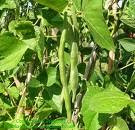Runner beans are unexcelled in cropping power by any other vegetable. Well-grown plants will yield a continuous supply of pods throughout the summer and right on till the frosts. Both the foliage and the flowers of the plants are handsome, and they are often used to good effect in screening off unsightly features or bare fences. For good cropping it is really essential to trench the land to a depth of at least 2 feet, breaking the bottom spit up with the digging fork and at the same time working in a generous dressing of old and well-rotted manure. On light land cow manure is the most suitable, but on heavy soil preference should be given to a strawy stable litter. This work must be completed in time for the soil to settle firmly before planting. The stakes provided for supporting the plants must be of a fair size and stout in nature.
Good strong poles or brushwood of any description will answer well, but a little added support should be given in the form of stouter end posts from which wires are strained along the outside of the stakes. Staking must be done in the very early stages, or the plants are bound to suffer through blowing about in high winds. Once they have started to climb they can, of course, be left to their own devices, as they are twining plants fully capable of clinging to their supports unaided. Regular picking before the pods have a chance to develop their seeds is the first essential to maintaining the supply. Mulching is also advisable, and during hot dry weather copious supplies of water should be given. When in full production the plants will appreciate regular feeding with liquid manure. It is also advisable to pinch the points out of the leading growths when they reach the top of the stakes, as this will encourage a branching habit, which in turn does much to increase the yield of pods.
Runner beans can be raised under glass planting out the first week in June in a double row a foot apart, allowing the same distance between the plants. The last week in May is quite early enough for an outdoor sowing. The seeds should be covered with about 2 in. of soil and thinned out as soon as large enough to handle to I ft. apart. It is a good plan in every case to scatter soot and lime around the plants to ward off attacks by slugs, which are very partial to the tender young seedlings.
Ian has a great interest in gardening and writes occasional articles. Come and visit his newest website at Orthomatic Adjustable Beds, and look particularly at the Leggett and Platt Adjustable Beds
Article Source: http://EzineArticles.com/?expert=Ian_SG_Smith
Growing Runner Beans
Hi my Name is Darren
I Started Growing my Own Food a few Years ago and i Love it.
When I Started it took Age's to find the Best information on How To Grow my Own Food.
So I have Put Together Some of The Best info I Found to Help others Like me to Grow there own.
Hope you Like it and i Hope it Help's
more will be added as i Find The Best info
Thank's Darren
When I Started it took Age's to find the Best information on How To Grow my Own Food.
So I have Put Together Some of The Best info I Found to Help others Like me to Grow there own.
Hope you Like it and i Hope it Help's
more will be added as i Find The Best info
Thank's Darren
